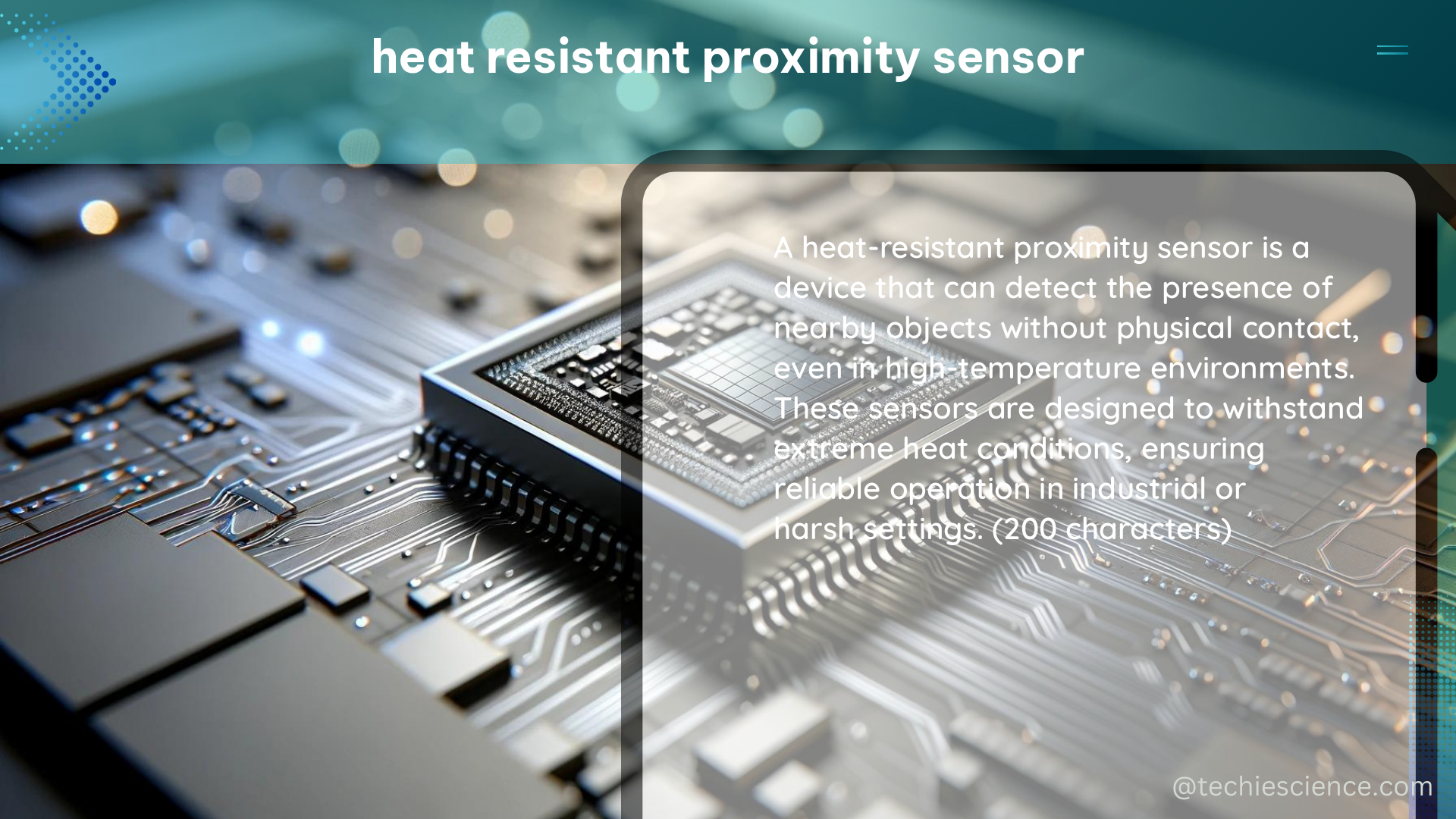Heat resistant proximity sensors are specialized devices designed to operate in high-temperature environments, often found in industrial processes and applications. These sensors are engineered to maintain their functionality and accuracy even in extreme temperatures, making them invaluable for applications where traditional sensors would fail.
Operating Temperature Range
One of the key technical specifications for heat resistant proximity sensors is their operating temperature range. This range can vary depending on the specific sensor model and manufacturer, but generally, these sensors are designed to operate in temperatures ranging from 200°C to 800°C. For example, the Honeywell HAF1100 series of heat resistant proximity sensors are rated for operation in temperatures up to 800°C.
| Sensor Model | Operating Temperature Range |
|---|---|
| Honeywell HAF1100 | Up to 800°C |
| Omega PROX-HT | 200°C to 600°C |
| Pepperl+Fuchs TC400 | 200°C to 400°C |
| Baumer IFRR 06 | 200°C to 450°C |
Measurement Range and Accuracy

Another important specification for heat resistant proximity sensors is their measurement range and accuracy. These sensors utilize various technologies, including inductive, capacitive, and ultrasonic sensing, to detect and measure the presence and distance of objects in their environment. These sensors are typically calibrated to provide accurate measurements within a specific range, with measurement errors and uncertainties typically specified in the sensor’s data sheet.
| Sensor Technology | Measurement Range | Typical Accuracy |
|---|---|---|
| Inductive | 2 mm to 60 mm | ±0.1 mm to ±0.5 mm |
| Capacitive | 1 mm to 30 mm | ±0.05 mm to ±0.2 mm |
| Ultrasonic | 20 mm to 1000 mm | ±0.2% to ±1% of full scale |
It’s important to note that the specific measurement range and accuracy of a heat resistant proximity sensor can vary depending on the manufacturer, model, and the application requirements.
Environmental Factors
In addition to their technical specifications, heat resistant proximity sensors also require careful consideration of their environmental factors, as outlined in the Sensor Technology Handbook. These factors include temperature, pressure, vibration, electromagnetic and electrostatic effects, and the rates of change of these environments. Proper selection and installation of these sensors can help minimize measurement errors and ensure accurate and reliable operation in extreme temperature environments.
Temperature
Heat resistant proximity sensors must be able to withstand and operate accurately in high-temperature environments. Factors such as thermal expansion, changes in material properties, and the potential for thermal drift can all impact sensor performance.
Pressure
High-pressure environments can also affect the performance of heat resistant proximity sensors. Factors such as mechanical stress, changes in material properties, and the potential for leaks must be considered.
Vibration
Industrial environments often involve high levels of vibration, which can impact the accuracy and reliability of heat resistant proximity sensors. Proper mounting and isolation techniques are essential to mitigate the effects of vibration.
Electromagnetic and Electrostatic Effects
Heat resistant proximity sensors must be designed to operate in environments with high levels of electromagnetic and electrostatic interference. Shielding, grounding, and other techniques may be necessary to ensure accurate and reliable measurements.
Building Your Own Heat Resistant Proximity Sensor
For those interested in building their own heat resistant proximity sensors, there are a variety of resources available online, including DIY guides and tutorials. These resources can provide detailed instructions on selecting the right components, designing and building the sensor, and calibrating and testing its performance.
When building a heat resistant proximity sensor, it’s essential to consider the following factors:
- Sensor Technology: Choose the appropriate sensing technology (inductive, capacitive, or ultrasonic) based on your application requirements.
- High-Temperature Components: Select components that are rated for the required operating temperature range, such as high-temperature-resistant electronics, housing materials, and cabling.
- Calibration and Testing: Develop a comprehensive calibration and testing procedure to ensure the sensor’s accuracy and reliability in the target environment.
- Environmental Considerations: Incorporate design features to mitigate the effects of temperature, pressure, vibration, and electromagnetic/electrostatic interference.
By carefully considering these factors, you can design and build a heat resistant proximity sensor that meets the specific requirements of your application.
Conclusion
Heat resistant proximity sensors are specialized devices designed to operate in extreme temperature environments, often found in industrial processes and applications. These sensors are engineered to maintain their functionality and accuracy even in temperatures ranging from 200°C to 800°C, making them invaluable for applications where traditional sensors would fail.
Key technical specifications for heat resistant proximity sensors include their operating temperature range, measurement range and accuracy, and environmental factors. By understanding these specifications and carefully selecting, installing, and calibrating these sensors, you can ensure accurate and reliable measurements in even the most challenging temperature environments.
For those interested in building their own heat resistant proximity sensors, there are a wealth of resources available online, providing detailed instructions on component selection, design, and testing. By following these guidelines, you can create a customized sensor solution that meets the unique requirements of your application.
References:
– Emerson Control Valve Handbook, Chapter 12: Process Safety Instrumented Systems
– FEMA RD Grant RD Abstracts FY 2005-FY 2021, Project Information Chart for EMW-2021-FP-00088
– NCBI Tactile Sensing for Minimally Invasive Surgery, Table 2: Comparison between the conventional tactile sensing technologies for MIS
– Sensor Technology Handbook, Section 1.2: Sensor Data Sheets
– Southern California Edison – 2020‐2022 Wildfire Mitigation Plan, Table 1: Five-year history of Progress Metrics

The lambdageeks.com Core SME Team is a group of experienced subject matter experts from diverse scientific and technical fields including Physics, Chemistry, Technology,Electronics & Electrical Engineering, Automotive, Mechanical Engineering. Our team collaborates to create high-quality, well-researched articles on a wide range of science and technology topics for the lambdageeks.com website.
All Our Senior SME are having more than 7 Years of experience in the respective fields . They are either Working Industry Professionals or assocaited With different Universities. Refer Our Authors Page to get to know About our Core SMEs.